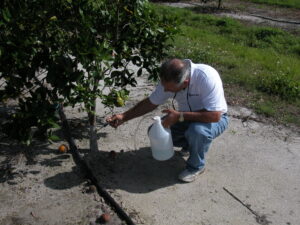CS 2005 Proven to Reduce HLB Titer in Trees
In the early days of HLB’s endemic spread across Florida, growers began trying many different products to mitigate the disease’s impact on grove productivity. At the time, there was a belief that any treatment that required each individual tree to be touched by a person was not viable because of the labor and expense of such an approach.
But as the disease continued its march and production declined, that belief changed. In 2023, formulations of oxytetracycline (OTC) were registered for use as a trunk-injection therapy for HLB. Growers now have performed two applications of the treatment and have learned that touching each tree is not the obstacle it was once believed to be.
ALTERNATIVE TREATMENTS
While the majority of Florida citrus acres have been treated twice with OTC, growers are faced with a break from applications next season per label requirements. That has set off the search for alternative treatments that will continue the progress of lowering HLB bacteria in trees.
 These alternatives would ideally be cost effective and meet fewer regulatory hurdles. Magna-Bon CS 2005 is a familiar tool in growers’ toolboxes and could fit the bill as a trunk-injection therapy. The soluble copper formulation has been a go-to product for canker and other diseases for many years.
These alternatives would ideally be cost effective and meet fewer regulatory hurdles. Magna-Bon CS 2005 is a familiar tool in growers’ toolboxes and could fit the bill as a trunk-injection therapy. The soluble copper formulation has been a go-to product for canker and other diseases for many years.
Research was conducted on the product’s potential in 2009 by the University of Florida Institute of Food and Agricultural Sciences and Southern Gardens Citrus. The idea was to test if injections of soluble copper into HLB-infected trees would provide plant health benefits by reducing Candidatus Liberibacter asiaticus in the phloem and other parts of the plant.
“This was in the early days of the HLB fight, but we felt like if we could get the product into direct contact with the HLB bacteria, we could reduce titer levels,” says Frank Miele, owner of Magna-Bon. “The research indicated that trunk injection of CS 2005 produced positive tree health benefits, reduced HLB bacteria and improved control of canker.
“Now that trunk injection is mainstream, we are conducting new research on optimum usage and going through the regulatory process to bring this application to growers as soon as possible.”
According to the research study summary: “All Magna-Bon treatments produced changes in canopy ratings that reflected positive responses compared to no change for the non-treated control trees. Ct values for non-treated control trees indicated positive HLB status, whereas Ct values for Magna-Bon treated trees were significantly higher and indicated negative or threshold (HLB) bacterial infection.”
“The study showed that our soluble formulation moves throughout the tree when injected,” Miele says. “It is very important to have a soluble formation to be taken up by the tree, but not all soluble formulations can have the bioactive units to fight bacterial diseases like CS 2005 has been proven to do through this and other research.”
That activity was confirmed in the research summary: “Alternatively, a bioassay for systemic copper activity was conducted with expanding fall flush by injection-infiltration of detached leaves with Xanthomonas citri subsp. citri (Xcc). Canker lesions were reduced in leaves treated with CS 2005 versus non-treated control trees, confirming copper from Magna-Bon is systemic in trees.”
INJECTION PROTOCOLS
Miele says work is being done now to develop exact recommendations for CS 2005 trunk injection, but the company will suggest three applications per season, along with the standard foliar application. The injection will be cost-effective at about 4 cents to 5 cents per tree.
“If you’ve injected OTC, this process is going to be no more difficult; it might even be easier,” Miele says. “Growers would be using the injection devices they already are using, and the timing of treatments would be the same as well. We will just be offering an alternative to OTC.”

